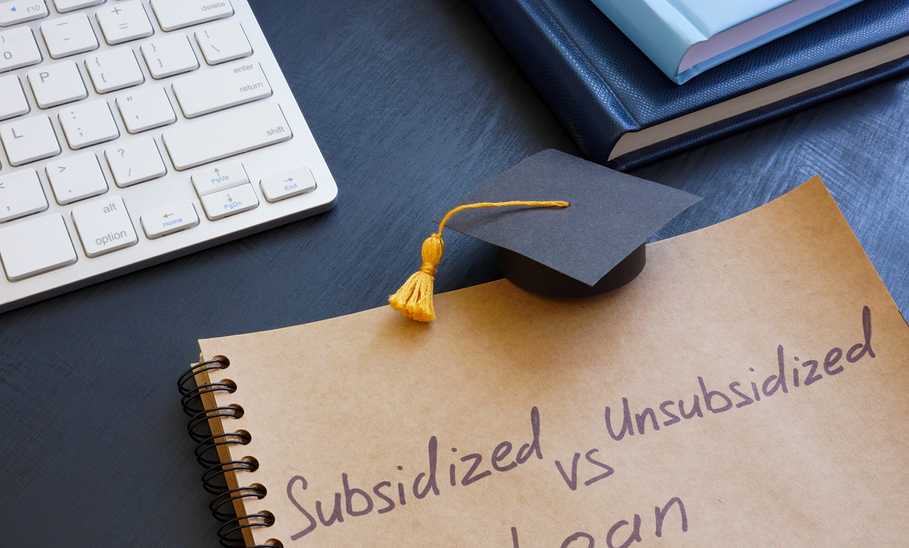Subsidized vs. Unsubsidized Student Loans: Which is Best for You?

Our evaluations and opinions are not influenced by our advertising relationships, but we may earn a commission from our partners’ links. This content is created by TIME Stamped, under TIME’s direction and produced in accordance with TIME’s editorial guidelines and overseen by TIME’s editorial staff. Learn more about it.
There are two types of federal student loans offered by the Department of Education (DoE): Direct Subsidized Loans and Direct Unsubsidized Loans.
The main difference between the two is students with subsidized loans don’t incur any interest under certain circumstances, such as when enrolled in school at least half-time. Students with unsubsidized loans do not get any breaks and interest starts to accrue as soon as the loan is paid out. Ultimately, it’s best to use subsidized student loans if you qualify, as you will pay less over time than with unsubsidized loans.
A subsidized loan is a type of federal student loan available to students who can demonstrate financial need. To determine financial need, your school will consider two variables:
Then a simple formula is used to calculate your financial need:
Cost of attendance (COA) - Expected Family Contribution (EFC) = Financial Need
For instance, if your COA is $20,000 and your EFC is $10,000, then your financial need is $10,000.
Unsubsidized loans are available to undergraduate, graduate and professional students and are not based on financial need. Eligibility is determined based on your COA and how much other financial aid you’ve received.
| Subsidized | Unsubsidized | |
|---|---|---|
Who can borrow | Undergraduates enrolled at least half-time | Undergrad, graduate, and professional degree students enrolled at least half-time |
Qualifications | Must demonstrate financial need | Any student can borrow |
Fees | Up to 1.059% | Up to 1.059% |
Interest Rates | 4.99% undergraduates | 4.99% undergraduates 6.54% for graduate and professional borrowers |
How interest is paid | Loans do not accrue interest while student is in school at least half-time or during deferment periods | Loan starts accruing interest as soon as you receive it |
Maximum loan amount | $23,000 | $31,000 dependent undergraduate $57,500 independent undergraduate $138,500 independent graduate student |
Repayment | 10-year repayment beginning six months after leaving school | 10-year repayment beginning six months after leaving school |
Subsidized: To be eligible for a subsidized student loan you must be enrolled in an undergraduate program at least half-time. You also must attend a school that participates in the Direct Loan program.
Unsubsidized: Undergraduate, graduate and professional degree students enrolled half-time are eligible for unsubsidized loans.
Subsidized: To qualify for a subsidized loan, you must demonstrate financial need based on Cost of Attendance (COA) and Expected Family Contribution (EFC).
Unsubsidized: You do not need to demonstrate financial need to qualify for an unsubsidized loan. It is up to your school to determine how much you can borrow based on your COA and the amount of other financial aid you receive.
Subsidized and unsubsidized: Loans paid out on or after October 1, 2019, and before October 1, 2020, have a loan fee of 1.059%. Loans paid out on or after October 1, 2020, and before October 1, 2023, have a loan fee of 1.057%.
Subsidized: The current interest rate for undergraduates of subsidized loans disbursed on or after July 1 2022, and before July 2023 is 4.99%.
Unsubsidized: The current interest rate for undergraduates is 4.99% and 6.54% for graduate and professional borrowers on unsubsidized loans disbursed on or after July 1 2022, and before July 2023.
The interest rates for subsidized and unsubsidized loans are fixed rates, and will remain the same for the entire life of the loan.
Subsidized With a subsidized loan, the Department of Education will pay the interest on your loan under certain conditions:
If you receive the maximum amount for a first-year undergraduate of $5,500 at 4.99% for a 10-year term, after a year of school and a six-month grace period, your monthly payments will be $58. You will pay $1,497 in total interest and your total borrowing cost will be $6,997 over the entire loan period.
Unsubsidized: With an unsubsidized loan, interest starts accruing as soon as you receive the money. If you decide you don’t want to make interest payments while you’re in school, the interest will accumulate and will be added to the loan total as capitalized interest.
Let’s say you receive the maximum amount in 2023 for a first-year undergraduate of $5,500 at a 4.99% interest rate for a 10-year term, and you don’t include your origination fees in the loan. As soon as you get your loan, you will start accruing interest. (For this example, we are calculating interest capitalization weekly.) By the time you graduate in May 2027 and you have to start repaying your loans, you will have added $1,444.63 in capitalized interest for a new loan balance of $6,944.63. You will pay a total of $1,894.40 in interest and your total borrowing costs will be $8,839.03.
It is up to your school to determine how much you are eligible for in student loans each year. There are maximum annual and total limits for both subsidized and unsubsidized loans. The limits depend on the year you are in school and whether you are an independent or dependent student.
Subsidized: The total loan subsidized loan limit is $23,000.
Unsubsidized: In general, the loan limit for unsubsidized loans is higher than for subsidized student loans. The total loan limit is $31,000 for dependent undergraduate students, $57,500 for independent undergraduates and $138,5000 for graduate or professional students.
Subsidized and unsubsidized: Once you graduate, leave school, or drop below half-time status, you have a six-month grace period before you have to start paying your loans.
To apply for subsidized and unsubsidized loans, you must fill out and submit the Free Application for Federal Student Aid (FAFSA). Make sure you submit it by the annual deadline. Your school will use your FAFSA to determine how much aid you are eligible for.
After submitting your FAFSA documentation, you will receive student aid packages from the schools you applied to. The aid package will outline the cost of attendance, if you received any grants or scholarships, and any federal student loan funding. Spend some time comparing your options to see which one makes the most sense for you. Once you decide, you need to respond to the aid letter.
If the amount of federal student loans you receive isn’t enough to cover your costs, you can look into other options, including federal parent loans, known as Direct PLUS loans. These are loans that your parents’ are responsible for paying. You can also look into private student loans.
Private student loans come from banks, credit unions, and some schools. Unlike federal student loans, which have terms and conditions set by law, the terms of private student loans (such as interest rates and repayment schedules) are set by the lender. Private student loans are typically more expensive than federal student loans. Federal student loans offer many important benefits, including the ability to tie your monthly repayment to your income, no prepayment penalty, and the potential for loan forgiveness. Also, you don’t need to do a credit check when you apply for a federal student loan (except with the Federal PLUS Loans).
You always want to apply for FAFSA before applying for private student loans to see what kind of government funding you can get. If you decide you need supplementary funding to fill a gap, you can compare private loan providers to see which one is right for you.
Ascent is a private loan provider that offers a variety of products to help fund your education, including cosigned and non-cosigned undergraduate loans, options for international students, DACA students and graduate students.
Another private lender is SoFi. SoFi has a selection of fixed and variable-rate undergraduate, graduate, professional, and parent loans. Like a federal student loan, SoFi grants a six-month grace period after graduation.
Private loan provider Earnest offers undergraduate, graduate, professional, and half-time student loans as well as cosigned options. Earnest also has a 100% rate match guarantee – it will match any competitor rate and give you a $100 Amazon gift card once the rate match is final.
LendKey is another private option. It provides student loans and refinance student loans. It’s a little different from the aforementioned private loan providers, as it partners with non-profit credit unions and banks to offer a variety of private loan options.
The best student loans are typically the ones that cost the least amount to borrow. If you qualify for subsidized student loans, you want to max these out before using unsubsidized student loans, as the government will pay your interest while you're in school and during deferments. Federal unsubsidized student loans are also a good option as they come with a fixed interest rate, income-driven repayment plans and a higher maximum loan amount than subsidized loans.
Student loans, including Direct Subsidized Loans, Direct Unsubsidized Loans and Direct PLUS Loans (for graduate and professional students), are funded by the government. Federal student loans come with terms and conditions set by law and have many benefits, including a fixed interest rate and income-driven repayment plans. Private student loans are available from non-federal lenders, including banks, credit unions, and schools with terms and conditions set by the lender.
If you are eligible for subsidized student loans, you want to use them first as they come with better terms, and the federal government pays your interest while you are in school or during deferments.
Unsubsidized student loans are another federal option, they are available to everyone, including graduate and professional students, and don’t require proof of financial need. You can also borrow more money with an unsubsidized loan. Unlike some private student loans, you don’t need to do a credit check to apply for an unsubsidized federal student loan.
Your school will determine the type of loan you qualify for. Only those who meet the financial need requirements are eligible for subsidized student loans.
The information presented here is created by TIME Stamped and overseen by TIME editorial staff. To learn more, see our About Us page.



